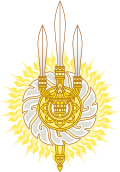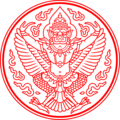Emblem of Thailand
| Emblem of Thailand ตราแผ่นดินของไทย (พระราชลัญจกรพระครุฑพ่าห์) | |
|---|---|
 | |
| Versions | |
 Another version with wider wings (usually mounted in front of a firm bearing royal warrant) | |
| Armiger | King of Thailand |
| Adopted | Originally adopted in Ayutthaya period. It was replaced by coat of arms of Siam until 1893. |
| Earlier version(s) | see text |
| Use | On all official documents and letters issued by Government of Thailand (e.g. Thai Government Gazette (ราชกิจจานุเบกษา), Constitutions of Thailand etc.). |
The National Emblem (National Symbol) of Thailand features the Garuda, a figure from both Buddhist and Hindu mythology. In Thailand, this figure is used as a symbol of the royal family and authority. This version of the figure is referred to as Khrut Pha, meaning "garuḍa, the vehicle (of Vishnu)." The National Emblem is also the Emblem of the King of Thailand.
The Garuda also features in the National Emblem of Indonesia and the city of Ulan Bator (the capital of Mongolia).
History
In 1873, King Chulalongkorn designed a coat of arms for use in Siam (the old name for Thailand), in the western heraldic style. Forty years later, he decided that the coat of arms was too westernized and lacked any image of the Garuda (which the kings of the Ayutthaya Kingdom had used as symbol of their power).
He then ordered his brother Prince Naris to make a new emblem in place of the coat of arms. At first, Naris had designed an emblem featuring Garuda, Naga and Vishnu inside a circle. The emblem was only used for a short while before the king suggested Naris removed the images of Vishnu and Naga.
After Chulalongkorn's reign, King Vajiravudh ordered Phra Dhevabhinimit (Thai: พระเทวาภินิมมิต (ฉาย เทียมศิลปชัย)) to create a new emblem. The new one featured Chulalongkorn's emblem, but encircled it to create an outer rim, which contained the royal ceremonial name. Upon coronation of a new king, the royal emblem is changed to correspond with the name of the new king. After the abdication of King Prajadhipok in 1935, King Ananda Mahidol succeeded to the throne, but he was never crowned, so a new emblem was not created and Chulalongkorn's emblem was used instead.
Today, an image of Garuda without the circle around it is used as the emblem of Thailand. It is printed at the top of official documents and letters. Garuda sculptures are given by king as a royal warrant to any reliable and lawful companies who made trade contract with royal household and request so.
Gallery
-
Seal of Siam, which featured Garuda, Naga and Lord Vishnu. It was used as a royal seal before Rama V's reign.
-
Seal of Siam. Drawn by Prince Naris to replace the coat of arms. It was only used for a short period.
-
Current version of Seal of Thailand. This version is used as the center part of the Thai royal seal, which is made by adding king's ceremonial name around it.
-
Garuda sculpture, which is given by king of Thailand as a royal warrant.
-
Emblem of Thailand as appeared in front of Royal Thai Embassy in Prague, Czech Republic.
Coat of arms of Siam 1873-1910
| Royal coat of arms of Siam พระราชลัญจกรประจำแผ่นดินสยาม | |
|---|---|
 | |
| Versions | |
 Version as appeared on state document | |
 Version used as a cap-badge of the Royal Thai Police. | |
| Armiger | Chulalongkorn the Great |
| Adopted | 1873-1910 |
| Crest | Great Crown of Victory and the Emblem of the Chakri Dynasty |
| Shield | Airavata , White Elephant and two Krises |
| Supporters | Gajasiha and Rajasiha |
| Compartment | Golden Royal seat |
| Motto | สพฺเพสํ สงฺฆภูตานํ สามคฺคี วุฑฺฒิ สาธิกา |
| Order(s) | The Order of the Nine Gems and the Order of Chula Chom Klao |
| Other elements | The Royal Regalia of Thailand |
| Use | On all official documents and letters issued by Government of Siam in the Fifth reign. |
From 1873 to 1910 Thailand (then known as Siam) had a heraldic style coat of arms as a national emblem. The coat of arms was created during the reign of King Chulalongkorn (Rama V), who ordered his cousin His Highness Prince Pravij Jumsai to draw up a European style coat of arms in 1873.
The Coat of Arms of the Kingdom of Siam (พระราชลัญจกรประจำแผ่นดินสยาม), follows and contains almost all components and elements of the European heraldic tradition. The escutcheon or Shield, is divided into three quadrants. The first (chief) quadrant depicts a mythological three-headed white elephant, or Erawan (เอราวัณ) (in Hindu mythology called Airavata) the vehicle of the god Indra, the creature is set on a yellow field. This quadrant represents the Kingdom of Siam and the Thai heartland, the three heads of the elephant represents the northern, central and southern Siam. The lower left quadrant (dexter base) depicts a white elephant in front of a red field. This quadrant represents the Laotian suzerainty (the symbol comes for its native name "Lan Xang", land of the million elephants.). The lower lower right quadrant (sinister base) depicts two crossed krises (one with and one without a scabbard) on a pink field, this represents the Malay suzerainty to the south.
Above the shield is the symbol representing the Chakri Dynasty, a disc and a trident (chakra and trisula). The shield is then surrounded by the chain of the Ancient and Auspicious Order of the Nine Gems (representing Buddhism) with a chain and pendant from the Most Illustrious Order of Chula Chom Klao (featuring a portrait of King Chulalongkorn).
The arms contains all of the six Royal Regalia of Thailand. Firstly the shield is crowned by the Great Crown of Victory, with a rays of light emitting from the 'Phra Maha Wichian Mani'; a diamond set atop the crown. Besides the shield are two seven-tiered Royal Umbrellas. Crossed behind the shield is the Sword of Victory to the left and the Royal Staff to the right. In front of them are the Royal Fan and Flywhisk (to the right and left, respectively). And finally on the compartment, a golden multi-layered base with a blue top, are the Royal Slippers, a pair of golden 'Indian' slippers.
The motto is written in gold on a red and green ribbon at the bottom of the arms. The motto, which is written in the Pali language in Thai script reads: "สพฺเพสํ สงฺฆภูตานํ สามคฺคี วุฑฺฒิ สาธิกา" (Sabbesaṃ saṅghabhūtānaṃ sāmaggī vuḍḍhi sādhikā), translated as:"Unity brings happiness". The supporters of the arms are two mythical creatures, clad in regalia. To the left of the shield (dexter) is an elephant lion (a lion with a trunk) or a 'Gajasiha' (คชสีห์). To the right of the shield (sinister) is a king of the lions the 'Rajasiha' (ราชสีห์). The two supporters represents the two ancient departments of Kalahom (Gajasiha) and Mahatthai (Rajasiha).
The Kalahom ministry is the department of the Military and the south, while the Mahatthai ministry is department of the civil service and the north, both vital in the administration of the Kingdom. Finally the mantle of the arms is the cloak of the Order of Chula Chom Klao, tied with pink ribbons (pink being the colour of Tuesday, the day of Chulalongkorn's birth).

When Vajiravudh succeeded his father as King Rama VI in 1910, he decided to replace the coat of arms with the current emblem. This was because the arms were too Westernized (at the time the King was trying to bolster Siamese Nationalism). Together with the fact that Siam by 1910 has lost the entirety of Laos to the French Empire (1893 and 1904) and the northern Malay States to the British Empire (1909).
Today the Coat of arms is still used as the cap-badge of the Royal Thai Police and is the official symbol of the Chulachomklao Royal Military Academy.
Emblem of the House of Chakri

The House of Chakri founded in 1782 by King Buddha Yodfa Chulaloke (or King Rama I) became the Royal House of Siam, and then later Thailand. King Rama I himself choose both name and the emblem for the dynasty. The Chakra which provides both name and the pictoral representation to the House of Chakri, is composed of the discus (Chakra) and the trident (Trisula), the celestial weapons of the Gods Narayana and Shiva respectively. The Siamese King is seen as a personification of the former. The coined name Chakri thus denotes the transcending force of divine strength and stability upon the physical realm.
See also
- Royal Warrant of Appointment (Thailand)
- Flag of Thailand
- Royal Standard of Thailand
- List of Thai Flags
- Monarchy of Thailand
- Chakri Dynasty
- Seals of The Provinces of Thailand
References
- สมบัติ พลายน้อย. ความรู้เรื่องตราต่าง ๆ พระราชลัญจกร (in Thai). รวมสาส์น.
- สำนักเลขาธิการคณะรัฐมนตรี (1996). พระราชลัญจกร (in Thai).
- ธงทอง จันทรางศุ. "การพระราชทานตราตั้งห้าง" (in Thai).





